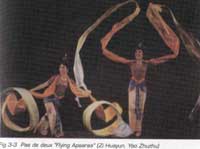EXCEPTS FROM CHINESE DANCE
by Sun Jingchen, Luo Xiongyan, Zi Huayun
Dai Ailian
Linking Up Chinese and Western Dances
In the reception hall of the British Royal Academy of Dance are displayed the statues of four outstanding female dancers. The stone sculpture of Dai Ailian is one of them. At the unveiling ceremony, she said with deep feeling, "The honor belongs to my motherland." The words from the bottom of her heart may explain well her dancing career.
Dai Ailian was born in Trinidad and Tobago, an independent republic in the West Indies in 1916, with her forefathers living abroad for many years. In 1930, she went to London to study dance. Many famous dancers such as Anton Dolin, Rudolf Laban and Mary Wigman had been her teachers. Though ballet and modem dance were not well connected at that time, Dai Ailian learned both of them. This is of great significance to her later development.
Dai Ailian resolutely returned to her homeland in 1939 after the Anti-Japanese War broke out. She gave benefit performances in Hong Kong and on the mainland. Major programs such as "Homesick Melody", "Selling", "Wheat Gleaning Girl" and "Story of the Guerrillas" demonstrated sympathy for the poor and concern over the nation's destiny.
During this period, Dai learned traditional Chinese culture and dance from art masters such as Zhang Daqian and Ye Qianyu.
In the 1940s, she herself produced and performed solo dances such as "Yao Drum" and "The Dumb Shouldering a Lunatic", which exerted a tremendous influence. The former was produced after she investigated the mountain area where the Yao ethnic group lived in compact communities; while the latter was refined from a drama episode (one acted as two characters: the older one shouldering the younger). Together with Tibetan dance "Ba'an Xianzi", Miao dance "Jarong Wine Party" and Uygur "Dance of Youth", they composed a colorful evening dance party in Chongqing. The performance was all the rage at the time. Dai helped develop folk dance by collecting different ethnic dances in different regions.
Dai Ailian's art career entered a golden period on the foundation of the People's Republic of China. She became the first president of the National Dance Troupe, the first headmistress of the Beijing Dance School and the first president of the Central Ballet Theater.
 Her representative work at this time was a group dance called the "Lotus Dance". The composer was Liu Chi and Xu Jie was the leading dancer. The original material was the "Lotus Lantern" widely spread in eastern Gansu and northern Shaanxi. Liu Chi once made some changes to it. In 1953, Dai Ailian choreographed it again, fully demonstrating the cleanness of the lotus that rises out of the silt. The dance had distinct characters, smooth movements and concise structure. The blossom lotus symbolized the prospering country (Fig.3-2)
Her representative work at this time was a group dance called the "Lotus Dance". The composer was Liu Chi and Xu Jie was the leading dancer. The original material was the "Lotus Lantern" widely spread in eastern Gansu and northern Shaanxi. Liu Chi once made some changes to it. In 1953, Dai Ailian choreographed it again, fully demonstrating the cleanness of the lotus that rises out of the silt. The dance had distinct characters, smooth movements and concise structure. The blossom lotus symbolized the prospering country (Fig.3-2)
 Another excellent work was a female pas de deux "Flying Apsara" (produced in 1954, composed by Liu Hang, and premiered by Xu jie and Zi Huayun). This was the first dance with materials drawn from Dunhuang frescoes. The "Long Silk Dance" from dramas was employed and turned into an independent dance art form. The dance did not stay at the redepiction of Dunhuang frescoes, but rather, it expressed People's hopes and yearning. The flying silk band and smooth, sliding and jumping steps turned people's mind to the sky (Fig.3-3)
Another excellent work was a female pas de deux "Flying Apsara" (produced in 1954, composed by Liu Hang, and premiered by Xu jie and Zi Huayun). This was the first dance with materials drawn from Dunhuang frescoes. The "Long Silk Dance" from dramas was employed and turned into an independent dance art form. The dance did not stay at the redepiction of Dunhuang frescoes, but rather, it expressed People's hopes and yearning. The flying silk band and smooth, sliding and jumping steps turned people's mind to the sky (Fig.3-3)
The "Lotus Dance" and "Flying Apsaras" were successively presented at the World Youth and Students Peace and Friendship Festival (hereinafter abbreviated as World Youth Festival) held in Berlin and Warsaw respectively in 1953 and 1955 and won awards. They were also included in the Dance Classics of the Chinese Nation in the 20th Century in 1994 and continue to flourish.
Dai Ailian always said: "Ballet is my work, while folk dance is my greatest pleasure." Her love for Chinese dance led to her unremitting efforts. Meanwhile, she introduced the essence of Western dance to China. For this reason, she was regarded as a qualified person to link up Chinese and Western dance culture.
